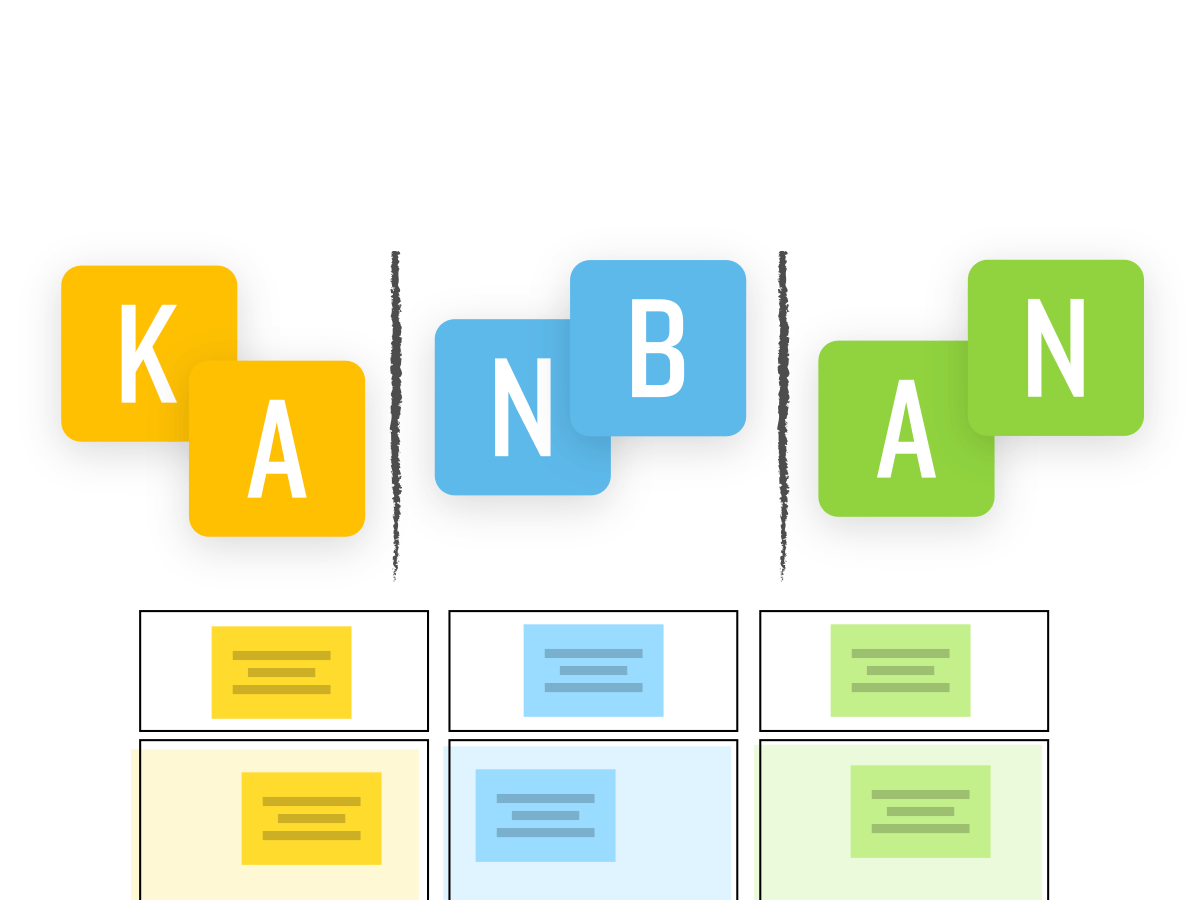Kanban: manage visually the projects' progress
Published on February 14, 2025
Kanban: manage visually the projects' progress


With the Kanban template, visualize the tasks to achieve, follow their progress and manage your projects as a team and with agility. Manage the workload and become more efficient as a team with the Kanban method! Pioneered by Toyota during the 1950s to optimize production capacity, the Kanban method allows teams to visualize and track their workload and progress, in one place. On an easy-to-use table, each team member moves tasks along a visual course of completion. Tasks start with "To do," then move to "doing," and then to "done" once completed. Just like that, each team member makes sure that everyone is able to fulfill their assigned tasks, on schedule.

Follow the progress of the project. Each idea goes from column to column: backlog (all the actions to be done), to do, wip (in progress) and done. A perfect method and tool to visually manage your projects, as a team, and even remotely!
Finding the best way of successfully steering a project to its end is not always an easy task. There are lots and lots of project management strategies, some of which will be better suited to your project than others. Some, for example, push teams to become excessively lean. Often this results in a lot of pain over the short-term (and sometimes the not-so-short-term).
What if we took a closer look at what teams can really do in a certain time, and designed task management accordingly, rather than just allocate tasks to everybody without proper consideration of their feasibility? That’s what the Kanban agile method seeks to do. Discover here what this Japanese method is all about and personalize Klaxoon’s Kanban template to your team’s needs and your next project! Teamwork assured!
In the 1950s, Japanese industrial engineer Taiichi Ōno developed a work method to improve Toyota employees’ productivity. At that point in time, productivity in Japan was much lower than in the US. Ōno thought up the concept of just-in-time manufacturing (JIT). It involves meeting but not exceeding market demand, producing only what can really be consumed at any given moment. JIT allows better production management, but requires a high level of responsiveness.
Which is what Kanban help you ahieve. In Japanese, kanban means billboard, as in the board on which employees put color cards that track stock levels within a company. The more stock there is, the longer you have to wait before you produce more, to avoid overproduction. Taiichi Ōno – seen by many as the father of job tracking – viewed the avoidance of overproduction as key to the success of production lines.
The success of this method in Japan was quick to attract attention from around the world. Many manufacturers other than car makers started using it also. For example, in the 2000s, software companies like Microsoft started using color cards. Have you maybe come across a visual management dashboard inspired by the Kanban method in big companies that sometimes stick their multicolored Post-Its in rows and columns on their windows?
Yes, you can! True, Kanban was first used in the world of manufacturing. But it’s easy – and highly recommended – to use it for project management in just about any sector. Kanban is above all a quick and efficient job scheduling tool built on cutting-edge concepts. Correct usage of the Kanban method spells successful teamwork.
The most important principle of the Kanban job management method is probably to always make do with what you have. It might seem counterproductive, but it’s by using the resources you already have (whether human, financial or time resources) that you can start to improve your internal project management processes. So, before you launch any changes, it’s crucial that you first define roles, responsibilities and tasks as they are at the outset.
Speaking of changes, another important Kanban principle is that you should never introduce change too suddenly or brutally, as that might meet with instant opposition from workers. Without the buy-in of each team member, projects don’t succeed. So, it’s better to limit the amount of changes introduced during a Kanban meeting (the famous ‘daily meetings’ for which we have included a ready-to-use template on Board). Rather wait and introduce them over time. With Kanban, teams progress slowly but surely.
The Kanban method offers you a clear and precise overview not only of your project’s big picture, but also the different tasks needed to steer it to success. Herein lies another important Kanban project management principle: you have to update the daily job scheduling table regularly and correctly. Keep the cards posted on your team’s Kanban table up to date all the time. But remember, the table is a jobs scheduling tool, not a to-do list to which you just keep adding things (until someone sounds the alarm!). Kanban is a visual project management method.
Most likely you have already designed visual management tools for your work without realizing that it’s called that way. It simply means you organize your work and jobs in a visual manner in such a way that all information is accessible and legible at first sight in one place. By combining on the same interface (i.e. on the same jobs scheduling table in the case of Kanban) all the information needed for a project to succeed, you save a lot of time. It allows seamless communication. And much better teamwork. During brainstorming sessions, or project updates, everybody will have access to the same information all the time. All of which ensures better management of team members.
Whether you meet remotely or all in the same place, it’s much easier to hold a Kanban project management meeting when you have at your disposal the right tools. Klaxoon’s Kanban template was designed for those who want to make the most of this tried and tested jobs scheduling method. All you need to do is personalize the title of each Kanban column, and invite your colleagues to join you on Board.
First, each team member will be invited to create a thumbnail with his/her name and picture (which is to be used during the last part of the project update). Together the team then moves to the first column of the Kanban table entitled ‘All actions to do’, where everyone adds the objectives he/she thinks are necessary for the project to succeed. The ideas can be added either through descriptions or pictures. Once everybody has contributed his/her ideas, together the team decides what importance to allocate to each action on the visual dashboard. What actions have been started on already? Which remain to be done? Which have been suspended? At this stage, care must be taken to abide by the Kanban principle not to overload the ‘To-Do Column’. Klaxoon’s template recommends that you keep it to a maximum of 20 tasks at a time. This helps keep teams motivated. It’s really encouraging to see tasks move from the ‘In Progress’ column to ‘Done’!
That rewarding moment can take place at two different times. The first is the ‘daily Kanban meeting’ (either remote or in-house). It’s a 15-minute get-together at which each team member is invited to share the progress he/she made the previous day. It’s also offers colleagues an opportunity to highlight problems experienced with any of the objectives listed on the Kanban table.
The other moment that the Kanban online project management table can be used is… well, anytime, 24/7! Which explains just why this agile project management tool of Klaxoon is so great. You can now communicate asynchronously with your colleagues. Meaning throughout the day – or night – you can post info on your progress, or ask your colleagues a Question. They, in turn, can read and react to your posts whenever they want. In a world where working from home and other remote locations has become the norm, the possibility for workers to work and progress at liberty without losing contact with the team is key to project success. Previously underutilized asynchronous meetings are now becoming the backbone of teams working in new ways.
Kanban comes from Japan and involves lean production processes designed to optimize existing means in a corporation or team. It’s described as an agile visual management technique. It can be adapted to other agile strategies such as the Scrum method.
So, Kanban and Scrum can be used together. But they are distinct. For example, Kanban agile introduces change slowly, over the medium- to long-term. Scrum is a far more repetitive method, with much shorter project development cycles. Still, Kanban job scheduling dashboards can be used for project updates by teams working with Scrum also!
There are many reasons why companies choose Kanban to change the way they hold project update meetings. In terms of employee motivation, it really is ideal because with a host of small jobs allocated to each and every worker, chances of project success rise considerably. It also strengthens team dynamics thanks to every decision being taken together by the team, and to the constant flow of information between members that Kanban generates.
From an organizational point of view also, the Kanban method is ideal as it allows a big-picture view of an project. At a glance, thanks to color-coded cards, you can estimate what percentage of the project is done or still to do. It’s a very practical project follow-up tool, particularly when used online. For example, the “Question” function available on Klaxoon’s online whiteboard allows team members to at any point in time post questions on any task in the Kanban template. Colleagues may answer asynchronously, or schedule a remote or inhouse meeting with you. Whatever format you choose, decision-making remains easy, fast and collective.
Yes. As with all new work methods, you should prepare yourself very well before launching a Kanban jobs management strategy in your team or for your project. First and foremost is team member buy-in. Success depends on that. Also, don’t let a job remain for a number of weeks, or even months in the ‘In Progress’ column before you sound the alarm. Be proactive. And reliable. Which also means the decision-making process must become more flexible, less top-down, more bottom-up.
Designed for the Kanban agile method, this template enables fast and easy tracking of teamwork. Decisions are taken together, in a few short minutes. And afterwards you check back whenever you wish, keeping your finger on the pulse of your project.


Start using the Kanban template from anywhere, synchronously or in async.
Get inspired by other templates from the same categories
Unlock your teamwork potential